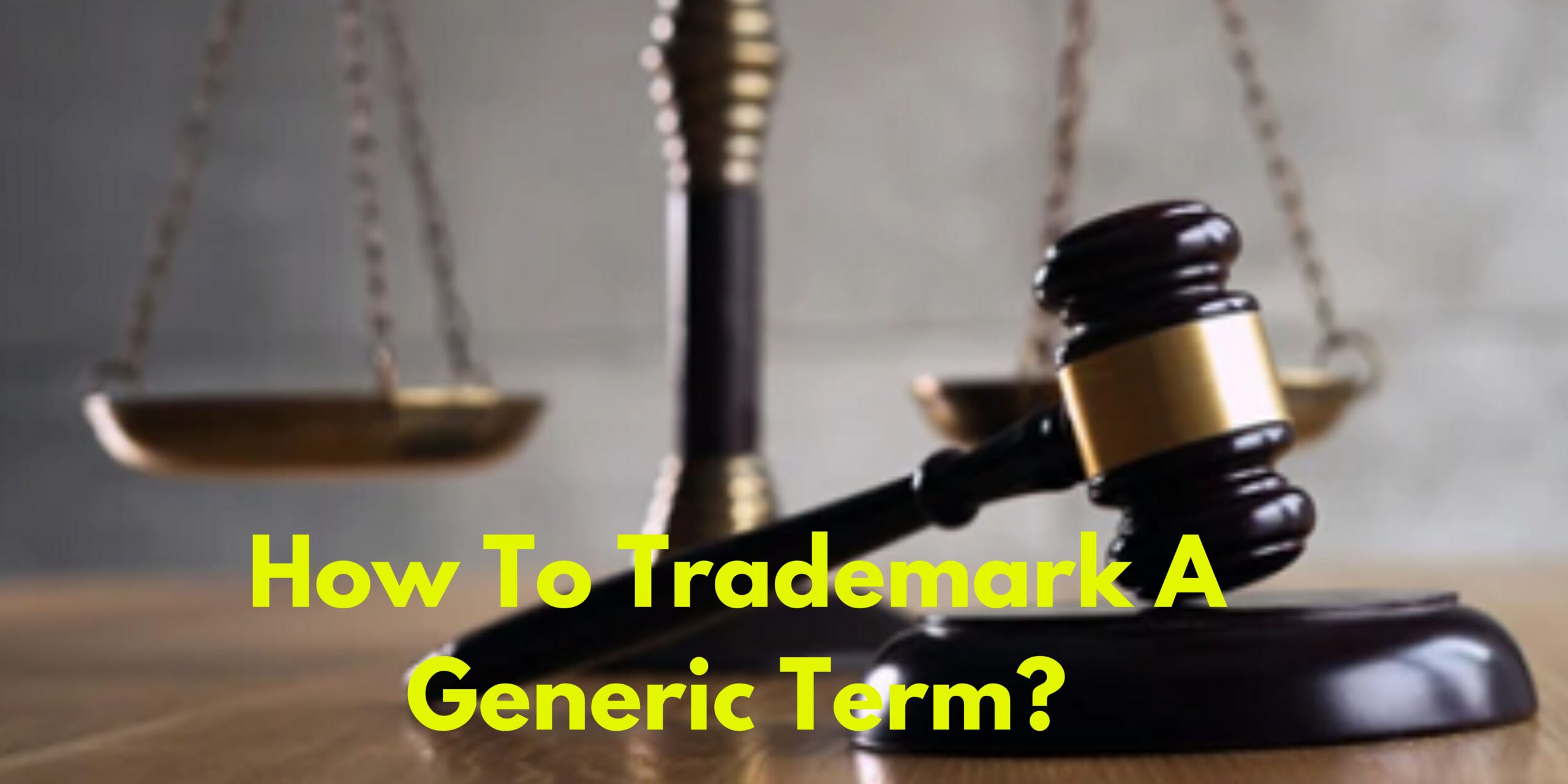How To Trademark A Generic Term?

Table of Contents
Trademarking a generic term is a complex process that involves overcoming significant legal hurdles. While it is generally difficult to trademark a generic term because it describes a general class of products or services, there are strategies and specific circumstances under which it may be possible.
Here’s to learning how to trademark a generic term.
Understanding Generic Terms
A generic term is a common name for a type of product or service, such as “coffee,” “shoes,” or “software.” These terms are considered too general to be associated exclusively with one brand. Trademarks, on the other hand, are meant to distinguish the products or services of one business from those of others.
Why Trademarking a Generic Term is Challenging
Trademarking a generic term is challenging because the purpose of a trademark is to identify the source of goods or services and distinguish them from others. A generic term, by definition, fails to do this because it refers to a general category rather than a specific source.
Legal Definition
The United States Patent and Trademark Office (USPTO) and courts generally do not grant trademarks for generic terms. The primary reason is that allowing one company to have exclusive rights to a generic term would unfairly limit competitors from describing their products or services accurately.
Consumer Confusion
Another reason for the difficulty is the potential for consumer confusion. If a generic term were trademarked, it could mislead consumers into thinking that only one company offers that type of product or service, which is not true.
Circumstances Allowing for Trademarking a Generic Term
Despite these challenges, there are certain circumstances under which you might be able to trademark a term that could be considered generic. These include acquiring distinctiveness and combining the term with distinctive elements.
Acquired Distinctiveness (Secondary Meaning)
A generic term may be trademarked if it has acquired distinctiveness or secondary meaning. This means that the term, through extensive and exclusive use in commerce, has come to be recognized by consumers as identifying a particular source of goods or services.
Combination with Distinctive Elements
Sometimes, a generic term can be trademarked if it is combined with other distinctive elements, such as a unique logo, design, or additional wording that makes the overall mark distinctive.
How To Trademark a Generic Term
Trademarking a generic term involves several steps, each crucial to ensure that your application is as strong as possible. Here are the steps you need to follow:
Step 1: Conduct a Thorough Search
Before you begin the trademark application process, conduct a comprehensive search to see if anyone else has attempted to trademark the same or a similar term. Use the USPTO’s Trademark Electronic Search System (TESS) and other online resources to ensure that your term is not already in use.
Search Variations: Look for different variations of the generic term, including common misspellings and similar sounding names.
Check Related Classes: Ensure that the term is not already used in related classes of goods or services.
Review Abandoned Trademarks: Understand why previous attempts to trademark the term were abandoned, as this can provide valuable insights.
Step 2: Develop a Strong Argument for Distinctiveness
To convince the USPTO that your generic term has acquired distinctiveness, you need to provide substantial evidence. This may include:
Length of Use: Demonstrate how long the term has been used in commerce and how it has become associated with your brand.
Advertising and Marketing: Show extensive use of the term in advertising and marketing materials, highlighting how it identifies your products or services specifically.
Consumer Recognition: Provide surveys, customer testimonials, and other evidence showing that consumers associate the term with your brand.
Step 3: Combine the Term with Distinctive Elements
Consider creating a trademark that combines the generic term with distinctive elements such as a unique logo, design, or additional wording. This can help make the overall mark distinctive and more likely to be approved by the USPTO.
Logo Design: Work with a professional designer to create a unique logo that incorporates the generic term.
Additional Wording: Add descriptive or suggestive wording that, when combined with the generic term, creates a distinctive trademark.
Step 4: File Your Trademark Application
Once you have developed a strong argument for distinctiveness and combined the term with distinctive elements, you can file your trademark application through the USPTO’s Trademark Electronic Application System (TEAS).
Choose the Appropriate Form: Depending on your circumstances, choose between TEAS Plus, TEAS RF, or TEAS Regular.
Provide Detailed Information: Include all necessary information in your application, such as the mark itself, the goods or services it will be used with, and the evidence supporting acquired distinctiveness.
Submit Specimens: Provide specimens showing how the mark is used in commerce. This could include product packaging, labels, or advertising materials.
Step 5: Monitor and Respond to Office Actions
After filing your application, the USPTO will review it and may issue an office action if there are any issues or objections. You will need to respond to these office actions promptly and effectively.
Common Objections: Be prepared to address common objections such as descriptiveness, likelihood of confusion, or lack of distinctiveness.
Legal Assistance: Consider hiring a trademark attorney to help you navigate the office action process and strengthen your case.
Costs of Trademarking a Generic Term
Trademarking a generic term can be more costly than trademarking a distinctive term due to the additional evidence and potential legal assistance required. Here are some of the costs you might incur:
Filing Fees
The USPTO charges a fee for filing a trademark application, which varies depending on the type of application you choose:
- TEAS Plus: $250 per class of goods or services.
- TEAS Reduced Fee (TEAS RF): $275 per class of goods or services.
- TEAS Regular: $350 per class of goods or services.
Famous Trademarked Generic Terms
Despite becoming a verb (“to google”) in everyday language, the trademark “Google” is vigorously protected by the company. The trademark ensures that “Google” is associated specifically with Google’s search engine and other related products and services, preventing others from using the term in a way that could dilute the brand’s identity.
Xerox
The term “Xerox” became so widely used that it was often used as a verb meaning “to photocopy.” Xerox Corporation has undertaken significant efforts to educate the public and media to use “Xerox” as a brand name rather than a generic term to protect its trademark. This includes campaigns emphasizing that Xerox is a brand of copiers, not a general term for the process of photocopying.
Kleenex
“Kleenex” has become a generic term for facial tissues in common language. However, Kimberly-Clark Corporation holds the trademark and works to ensure that “Kleenex” is recognized as a brand name. The company reinforces this through marketing and packaging, clearly indicating that Kleenex is a trademarked brand of facial tissues.
Band-Aid
Similar to Kleenex, “Band-Aid” is often used generically to refer to any adhesive bandage. Johnson & Johnson actively promotes Band-Aid as a brand name through advertising and branding efforts, ensuring that the trademark remains strong and legally protected.
Velcro
The term “Velcro” is frequently used generically to describe hook-and-loop fasteners. Velcro Companies has launched educational campaigns, including humorous videos, to remind consumers and the media that “Velcro” is a brand name. The company encourages the use of terms like “hook-and-loop fastener” when referring to similar products not manufactured by Velcro Companies.
Escalator
The term “escalator” eventually became generic due to widespread usage to describe any moving staircase, leading to the loss of its trademark protection. This case serves as a cautionary tale about the importance of protecting a brand from becoming generic through proactive branding and legal efforts.
Thermos
“Thermos” became a generic term for vacuum flasks, resulting in the loss of trademark protection in many jurisdictions. The Thermos brand still exists, but it highlights the challenge of maintaining a trademark for a term that becomes widely used to describe a general category of products.
Hoover
In the UK, “Hoover” is often used as a verb meaning “to vacuum.” Despite this, the Hoover Company continues to hold and protect the trademark. The brand name is maintained through consistent branding and marketing efforts to remind consumers that Hoover is a specific brand of vacuum cleaners.
Contact Us:
If you have any questions or need assistance with trademarking a generic term, our team of experts is here to help. Contact us today to learn more about how we can help you safeguard your brand and enhance your business.

Sissie Hsiao
Sissie Hsiao is the Vice President of Content Marketing and an innovator at heart. With a deep expertise in law, she specializes in the cutting-edge application of trademark and copyright. Sissie's unique blend of legal knowledge and marketing acumen drives her passion for developing forward-thinking content strategies that protect and promote creative works.




